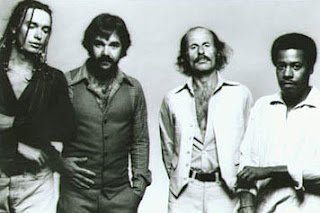Without a doubt, Weather Report was the most innovative jazz ensemble of the twentieth century. That’s a big statement, I know, but there was no other group that compared in compositional or playing prowess, and few that reigned as long.
 |
| L to R: Jaco Pastorius, Peter Erskine, Joe Zawinul, Wayne Shorter |
The sixteen year history of Weather Report is well documented elsewhere, but briefly, the band was the brainchild of pianist Joe Zawinul, saxophonist Wayne Shorter, and bassist Miraslov Vitous in 1970, with the first album release during the same year. Despite the sensational response of the first six albums over six years and some changes in personnel, it was not until bassist Jaco Pastorius became a regular member of the band that they reached their full potential and produced their best work.
The release in 1977 of their 7th studio album, the multi-award winning album HEAVY WEATHER, cemented Weather Report’s position at the very top of jazz groups. Every track is superb. MR. GONE (1978), the second album with Jaco on board full time did nearly as well, and with the addition of new drummer Peter Erskine, they produced 8:30 (1979), what I consider to be their best album, one that contained live versions of tunes from prior albums. That group produced two more albums, NIGHT PASSAGE (1980) and WEATHER REPORT (1982). Zawinul and Shorter continued with a new group in 1983 and produced four more studio albums.
Best recordings:
From HEAVY WEATHER (a truly inspired album), Birdland, A Remark You Made, both by Zawinul, and Teen Town
From MR. GONE, Jaco Pastorius’s Punk Jazz takes off like a rocket, with Jaco all over the bass and Tony Williams on drums. Then it evolves into a rich chordal passage of the hippest voicings ever, in an incredible hard-swing beat, and a monster soprano solo by Shorter.
 From 8:30, Birdland and A Remark You Made (live versions) are prime examples of Weather Report’s peerless ensemble work and compositions. Zawinul wrote Birdland first for HEAVY WEATHER, but on 8:30 they change the tempo from the original straight eights to a driving jazz swing with Jaco’s wicked walking bass line and Peter Erskine’s drumming leading the way. Jaco’s laying down of the melody with harmonics on his fretless bass is nothing less than awesome. The energy and tempo intensify to a near breaking point toward the end. The entire album of 8:30 is a masterpiece. The live version of In a Silent Way, written originally by Zawinul and made famous by Miles Davis, is the other must-listen on 8:30. Zawinul and Shorter do it as a duet, and rarely have three minutes of jazz ever been so beautiful. The track Slang, also a must-listen tour de force, I’m saving for the full discussion of Jaco Pastorius in a separate blog posting.
From 8:30, Birdland and A Remark You Made (live versions) are prime examples of Weather Report’s peerless ensemble work and compositions. Zawinul wrote Birdland first for HEAVY WEATHER, but on 8:30 they change the tempo from the original straight eights to a driving jazz swing with Jaco’s wicked walking bass line and Peter Erskine’s drumming leading the way. Jaco’s laying down of the melody with harmonics on his fretless bass is nothing less than awesome. The energy and tempo intensify to a near breaking point toward the end. The entire album of 8:30 is a masterpiece. The live version of In a Silent Way, written originally by Zawinul and made famous by Miles Davis, is the other must-listen on 8:30. Zawinul and Shorter do it as a duet, and rarely have three minutes of jazz ever been so beautiful. The track Slang, also a must-listen tour de force, I’m saving for the full discussion of Jaco Pastorius in a separate blog posting. NIGHT PASSAGE is the most contemplative album of that group. Dream Clock is a must listen, with exquisite soprano by Shorter and melodic bass by Jaco. Zawinul’s arrangement of Rockin’ in Rhythm (the Ellington tune) is electric and supercharged with energy.
WEATHER REPORT (1982) is the last album with Pastorius and Erskine. Must-listen tracks are Shorter’s Then It Was Now with its way-hip Caribbean funk beat, and Speechless, another touching ballad by Zawinul in the haunting style of so many of his ballads.
PROCESSION (1983) takes off with three new sidemen: Victor Bailey on bass, Omar Hakim on drums and Jose Rossy on percussion. Shorter’s Plaza Real is outstanding. PROCESSION and the next album, DOMINO THEORY (1984) explore some new sounds, which, in my view, reach their peak with SPORTIN’ LIFE (1985), an album of beautiful rhythms and melody, and THIS IS THIS (1986), their final studio album. A must-listen track on SPORTIN’ LIFE is Corner Pocket with its driving beat full of great ‘kicks’, synthesized big-band sound, its uncomplicated melody and the F# surprise in the key of F. The other is What’s Going On, a sensitive cover of Marvin Gaye’s tune that brings back memories of Jaco’s direction with the group. The whole album is a delight.
The must-listen off THIS IS THIS is the title tune This is This. It has a Michael Jackson-like funk-dance beat, a driving Santana guitar solo throughout, and Zawinul’s upbeat synth chord comping that could induce a dead person to get up and dance. While you’re at it, listen to I’ll Never Forget You, an exquisite ballad by Zawinul in memory of his parents, and a soft landing for Weather Report’s last album. Those nineteen tracks should get you started.
Also sample http://www.youtube.com/watch?v=U5c3H6LpLZI and
http://www.youtube.com/watch?v=pqashW66D7o&feature=fvwrel
See also: google: Greg Armbruster/Zawinul for an in depth interview with Joe Zawinul
Also sample http://www.youtube.com/watch?v=U5c3H6LpLZI and
http://www.youtube.com/watch?v=pqashW66D7o&feature=fvwrel
See also: google: Greg Armbruster/Zawinul for an in depth interview with Joe Zawinul


